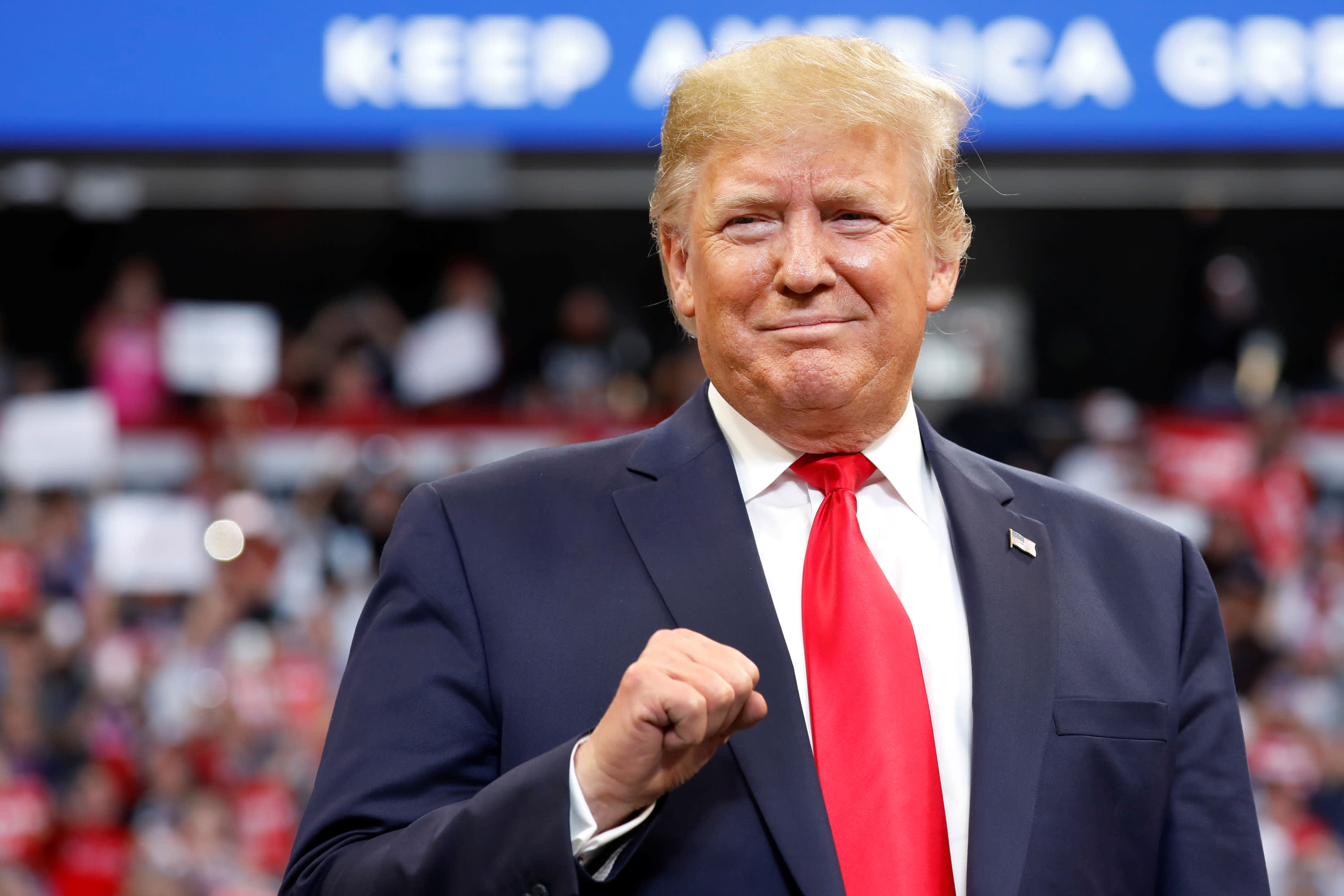President Donald Trump delivers remarks at a Keep America Great Rally at the Rupp Arena in Lexington, Kentucky, November 4, 2019.
Yuri Gripas | Reuters
President Donald Trump is not expected to impose new tariffs on China this weekend, but he may not have much of a trade deal to show either.
That promise, however, should be enough to satisfy the stock market, which was soaring after the president tweeted that he expects a “very big” deal with China and both sides want it. The S&P 500, Dow and Nasdaq were trading at all time highs Thursday but gave up some of their gains in late morning trading.
Trump set a Dec. 15 deadline on a new batch of tariffs on $156 billion in Chinese goods, which targeted many consumer products, such as cell phones, laptops and toys.
“This is the president helping the Santa Claus rally even more,” said Prudential Financial chief market strategist Quincy Krosby. “This is as much of a signal as we’ve wanted.”
Krosby added that while there have been plenty of headlines on trade, Trump has been relatively quiet lately and this declaration is particularly meaningful ahead of the deadline, since it is coming from him and he says both sides want a deal. It is also a big contrast to Trump’s Dec. 3 comment that he could wait until after the election for a deal, which sent the Dow skidding more than 450 points.
Trump was to meet with his advisers at the White House Thursday, as the weekend deadline approaches.
“The devil is in the details. If you just look at his sound bites on Oct. 11, they’re identical to what he just said. The chances of more tariffs on the 15th are slim,” said Greg Valliere, chief U.S. policy strategist at AGF Investments. “I think they’ll find some way to finesse that. In terms of some big sweeping deal, it’s either a wimpy deal or no deal.”
Trump on Oct. 11 said “good things” are happening with negotiations, but that was two months ago and since then there have not been much in the way of signs of concrete progress.
Dow Jones reported Thursday that U.S. negotiators offered to cancel the new tariffs that would take effect Sunday and were also willing to cut existing tariffs by up to 50% on $360 billion of Chinese goods. A roll back on the existing tariffs was considered to be an important and potentially deal breaking request from China.
“One thing you can be sure of is [Trump] will spin this as a great victory. To be fair, he’s had a hell of a week. He’s going to be acquitted in the Senate. He got a defense bill with family leave for federal workers and apparently the USMCA,” Valliere said, noting that the trade agreement with Canada and Mexico could take awhile to get through the Senate. “If we avoid tariffs on the 15th, it’s a plus for the markets.”
The base case for many Wall Street firms has been that the tariffs would not be implemented Sunday, and there would either be a phase one deal, focused on China buying U.S. agricultural products or at least a commitment to an agreement in the near future. The tougher parts of the negotiations are expected to resume next year, on such issues as intellectual property and technology transfers.
Ethan Harris, Bank of America Merrill Lynch global head of economics, said recently that he expected a deal but it couldn’t be ruled out completely that the U.S. would walk away if negotiations failed.
“With markets seemingly pricing a very high probability of a deal, ‘no deal’ could be very disruptive,” he wrote. But he does expect a deal that would build on concessions that have already been offered.
“Most important, it likely includes an increase in agricultural imports by China and an indefinite delay of the October and December tariffs. Beyond this there is greater uncertainty,” he noted. “Our base case is that China makes modest compromises on financial-sector access, intellectual-property protection and FX transparency. In return, we think the US removes the ‘manipulator’ label and extends waivers for US companies to sell inputs to Huawei.”
Harris put low odds on a comprehensive deal. “The US-China conflict is much broader than the trade war. It is a struggle between the world’s leading superpowers, and between fundamentally different economic models,” he noted. “There are many flash points in this struggle. The most important and hardest to resolve is the tech war, which combines concerns about fairness in trade, long-run economic growth and national security.”
Goldman Sachs economists also expect a deal in which the U.S. would delay or scrap the December tariffs and roll back Sept. 1 tariffs of about $100 billion in return for China buying agricultural products and other concessions.
“Under this baseline scenario, we expect the trade war drag on growth to fade by the end of 2020,” they wrote. “However, if the escalation continued and the December tariffs were to go into effect, the trade drag on sequential 2020 growth would be 0.4pp larger than in our baseline.”
-CNBC’s Michael Bloom contributed to this story
